Pål Halvorsen
ExposureEngine: Oriented Logo Detection and Sponsor Visibility Analytics in Sports Broadcasts
Oct 06, 2025Abstract:Quantifying sponsor visibility in sports broadcasts is a critical marketing task traditionally hindered by manual, subjective, and unscalable analysis methods. While automated systems offer an alternative, their reliance on axis-aligned Horizontal Bounding Box (HBB) leads to inaccurate exposuremetrics when logos appear rotated or skewed due to dynamic camera angles and perspective distortions. This paper introduces ExposureEngine, an end-to-end system designed for accurate, rotation-aware sponsor visibility analytics in sports broadcasts, demonstrated in a soccer case study. Our approach predicts Oriented Bounding Box (OBB) to provide a geometrically precise fit to each logo regardless of the orientation on-screen. To train and evaluate our detector, we developed a new dataset comprising 1,103 frames from Swedish elite soccer, featuring 670 unique sponsor logos annotated with OBBs. Our model achieves a mean Average Precision (mAP@0.5) of 0.859, with a precision of 0.96 and recall of 0.87, demonstrating robust performance in localizing logos under diverse broadcast conditions. The system integrates these detections into an analytical pipeline that calculates precise visibility metrics, such as exposure duration and on-screen coverage. Furthermore, we incorporate a language-driven agentic layer, enabling users to generate reports, summaries, and media content through natural language queries. The complete system, including the dataset and the analytics dashboard, provides a comprehensive solution for auditable and interpretable sponsor measurement in sports media. An overview of the ExposureEngine is available online: https://youtu.be/tRw6OBISuW4 .
From Flat to Feeling: A Feasibility and Impact Study on Dynamic Facial Emotions in AI-Generated Avatars
Jun 16, 2025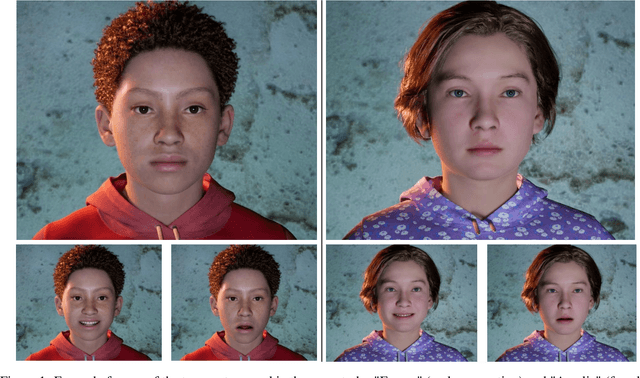
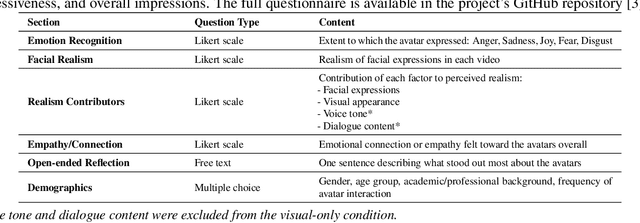
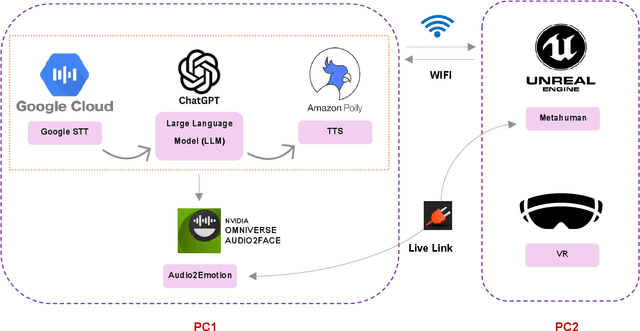

Abstract:Dynamic facial emotion is essential for believable AI-generated avatars; however, most systems remain visually inert, limiting their utility in high-stakes simulations such as virtual training for investigative interviews with abused children. We introduce and evaluate a real-time architecture fusing Unreal Engine 5 MetaHuman rendering with NVIDIA Omniverse Audio2Face to translate vocal prosody into high-fidelity facial expressions on photorealistic child avatars. We implemented a distributed two-PC setup that decouples language processing and speech synthesis from GPU-intensive rendering, designed to support low-latency interaction in desktop and VR environments. A between-subjects study ($N=70$) using audio+visual and visual-only conditions assessed perceptual impacts as participants rated emotional clarity, facial realism, and empathy for two avatars expressing joy, sadness, and anger. Results demonstrate that avatars could express emotions recognizably, with sadness and joy achieving high identification rates. However, anger recognition significantly dropped without audio, highlighting the importance of congruent vocal cues for high-arousal emotions. Interestingly, removing audio boosted perceived facial realism, suggesting that audiovisual desynchrony remains a key design challenge. These findings confirm the technical feasibility of generating emotionally expressive avatars and provide guidance for improving non-verbal communication in sensitive training simulations.
Kvasir-VQA-x1: A Multimodal Dataset for Medical Reasoning and Robust MedVQA in Gastrointestinal Endoscopy
Jun 11, 2025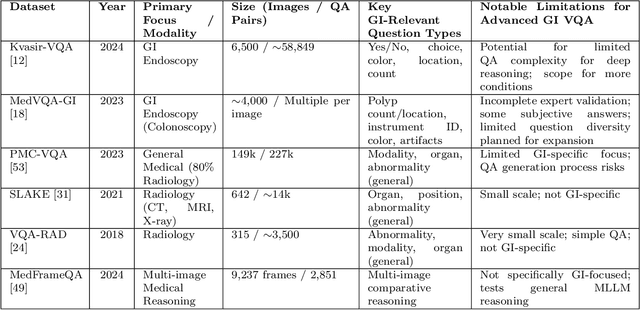
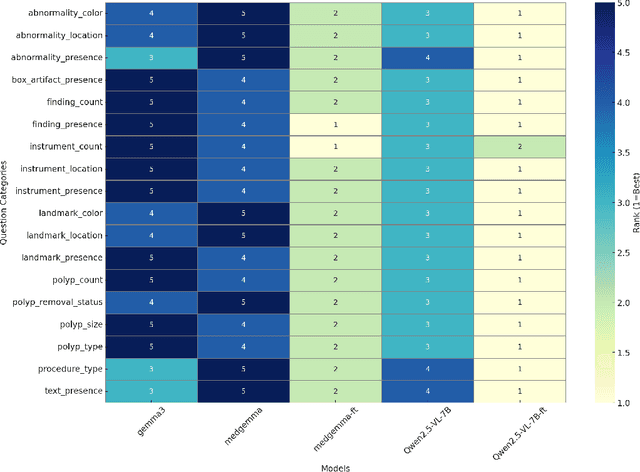
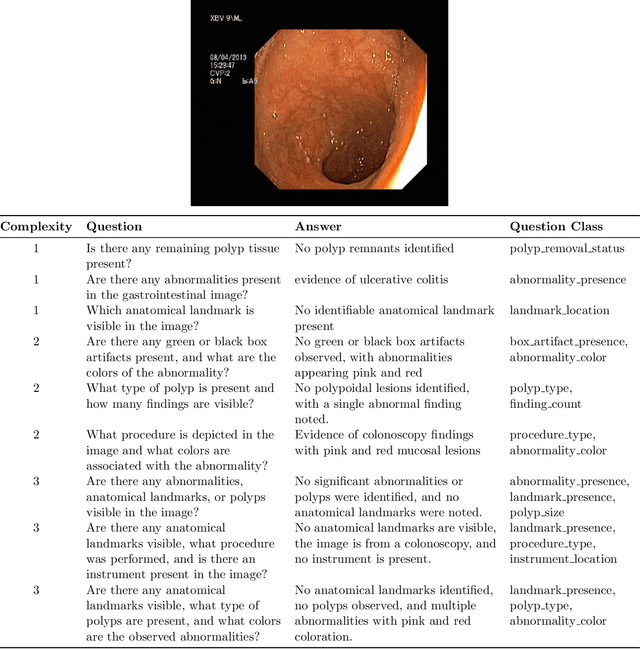
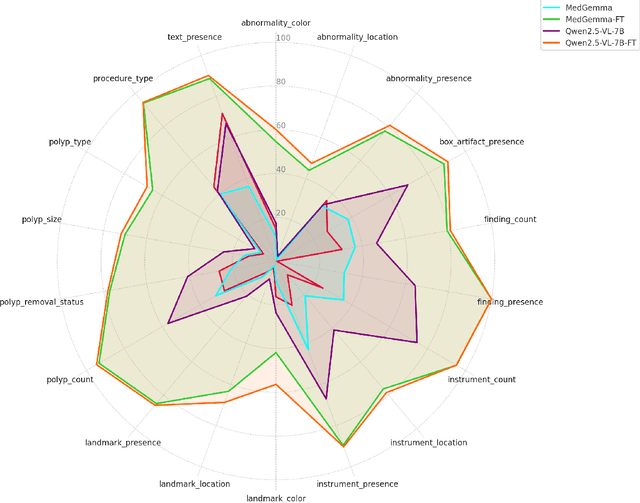
Abstract:Medical Visual Question Answering (MedVQA) is a promising field for developing clinical decision support systems, yet progress is often limited by the available datasets, which can lack clinical complexity and visual diversity. To address these gaps, we introduce Kvasir-VQA-x1, a new, large-scale dataset for gastrointestinal (GI) endoscopy. Our work significantly expands upon the original Kvasir-VQA by incorporating 159,549 new question-answer pairs that are designed to test deeper clinical reasoning. We developed a systematic method using large language models to generate these questions, which are stratified by complexity to better assess a model's inference capabilities. To ensure our dataset prepares models for real-world clinical scenarios, we have also introduced a variety of visual augmentations that mimic common imaging artifacts. The dataset is structured to support two main evaluation tracks: one for standard VQA performance and another to test model robustness against these visual perturbations. By providing a more challenging and clinically relevant benchmark, Kvasir-VQA-x1 aims to accelerate the development of more reliable and effective multimodal AI systems for use in clinical settings. The dataset is fully accessible and adheres to FAIR data principles, making it a valuable resource for the wider research community. Code and data: https://github.com/Simula/Kvasir-VQA-x1 and https://huggingface.co/datasets/SimulaMet/Kvasir-VQA-x1
SoccerChat: Integrating Multimodal Data for Enhanced Soccer Game Understanding
May 22, 2025Abstract:The integration of artificial intelligence in sports analytics has transformed soccer video understanding, enabling real-time, automated insights into complex game dynamics. Traditional approaches rely on isolated data streams, limiting their effectiveness in capturing the full context of a match. To address this, we introduce SoccerChat, a multimodal conversational AI framework that integrates visual and textual data for enhanced soccer video comprehension. Leveraging the extensive SoccerNet dataset, enriched with jersey color annotations and automatic speech recognition (ASR) transcripts, SoccerChat is fine-tuned on a structured video instruction dataset to facilitate accurate game understanding, event classification, and referee decision making. We benchmark SoccerChat on action classification and referee decision-making tasks, demonstrating its performance in general soccer event comprehension while maintaining competitive accuracy in referee decision making. Our findings highlight the importance of multimodal integration in advancing soccer analytics, paving the way for more interactive and explainable AI-driven sports analysis. https://github.com/simula/SoccerChat
Point, Detect, Count: Multi-Task Medical Image Understanding with Instruction-Tuned Vision-Language Models
May 22, 2025Abstract:We investigate fine-tuning Vision-Language Models (VLMs) for multi-task medical image understanding, focusing on detection, localization, and counting of findings in medical images. Our objective is to evaluate whether instruction-tuned VLMs can simultaneously improve these tasks, with the goal of enhancing diagnostic accuracy and efficiency. Using MedMultiPoints, a multimodal dataset with annotations from endoscopy (polyps and instruments) and microscopy (sperm cells), we reformulate each task into instruction-based prompts suitable for vision-language reasoning. We fine-tune Qwen2.5-VL-7B-Instruct using Low-Rank Adaptation (LoRA) across multiple task combinations. Results show that multi-task training improves robustness and accuracy. For example, it reduces the Count Mean Absolute Error (MAE) and increases Matching Accuracy in the Counting + Pointing task. However, trade-offs emerge, such as more zero-case point predictions, indicating reduced reliability in edge cases despite overall performance gains. Our study highlights the potential of adapting general-purpose VLMs to specialized medical tasks via prompt-driven fine-tuning. This approach mirrors clinical workflows, where radiologists simultaneously localize, count, and describe findings - demonstrating how VLMs can learn composite diagnostic reasoning patterns. The model produces interpretable, structured outputs, offering a promising step toward explainable and versatile medical AI. Code, model weights, and scripts will be released for reproducibility at https://github.com/simula/PointDetectCount.
Energy-Conscious LLM Decoding: Impact of Text Generation Strategies on GPU Energy Consumption
Feb 17, 2025



Abstract:Decoding strategies significantly influence the quality and diversity of the generated texts in large language models (LLMs), yet their impact on computational resource consumption, particularly GPU energy usage, is insufficiently studied. This paper investigates the relationship between text generation decoding methods and energy efficiency, focusing on the trade-off between generation quality and GPU energy consumption across diverse tasks and decoding configurations. By benchmarking multiple strategies across different text generation tasks, such as Translation, Code Summarization, and Math Problem Solving, we reveal how selecting appropriate decoding techniques with their tuned hyperparameters affects text quality and has measurable implications for resource utilization, emphasizing the need for balanced optimization. To the best of our knowledge, this study is among the first to explore decoding strategies in LLMs through the lens of energy consumption, offering actionable insights for designing resource-aware applications that maintain high-quality text generation.
Principal Components for Neural Network Initialization
Jan 31, 2025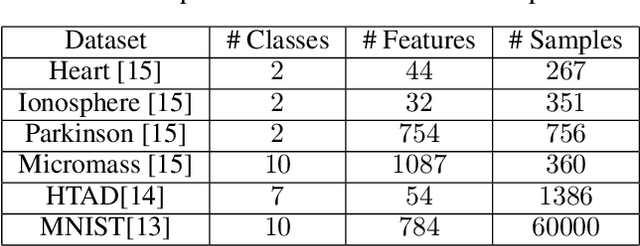



Abstract:Principal Component Analysis (PCA) is a commonly used tool for dimension reduction and denoising. Therefore, it is also widely used on the data prior to training a neural network. However, this approach can complicate the explanation of explainable AI (XAI) methods for the decision of the model. In this work, we analyze the potential issues with this approach and propose Principal Components-based Initialization (PCsInit), a strategy to incorporate PCA into the first layer of a neural network via initialization of the first layer in the network with the principal components, and its two variants PCsInit-Act and PCsInit-Sub. Explanations using these strategies are as direct and straightforward as for neural networks and are simpler than using PCA prior to training a neural network on the principal components. Moreover, as will be illustrated in the experiments, such training strategies can also allow further improvement of training via backpropagation.
DPERC: Direct Parameter Estimation for Mixed Data
Jan 17, 2025Abstract:The covariance matrix is a foundation in numerous statistical and machine-learning applications such as Principle Component Analysis, Correlation Heatmap, etc. However, missing values within datasets present a formidable obstacle to accurately estimating this matrix. While imputation methods offer one avenue for addressing this challenge, they often entail a trade-off between computational efficiency and estimation accuracy. Consequently, attention has shifted towards direct parameter estimation, given its precision and reduced computational burden. In this paper, we propose Direct Parameter Estimation for Randomly Missing Data with Categorical Features (DPERC), an efficient approach for direct parameter estimation tailored to mixed data that contains missing values within continuous features. Our method is motivated by leveraging information from categorical features, which can significantly enhance covariance matrix estimation for continuous features. Our approach effectively harnesses the information embedded within mixed data structures. Through comprehensive evaluations of diverse datasets, we demonstrate the competitive performance of DPERC compared to various contemporary techniques. In addition, we also show by experiments that DPERC is a valuable tool for visualizing the correlation heatmap.
Enhancing Naturalness in LLM-Generated Utterances through Disfluency Insertion
Dec 17, 2024



Abstract:Disfluencies are a natural feature of spontaneous human speech but are typically absent from the outputs of Large Language Models (LLMs). This absence can diminish the perceived naturalness of synthesized speech, which is an important criteria when building conversational agents that aim to mimick human behaviours. We show how the insertion of disfluencies can alleviate this shortcoming. The proposed approach involves (1) fine-tuning an LLM with Low-Rank Adaptation (LoRA) to incorporate various types of disfluencies into LLM-generated utterances and (2) synthesizing those utterances using a text-to-speech model that supports the generation of speech phenomena such as disfluencies. We evaluated the quality of the generated speech across two metrics: intelligibility and perceived spontaneity. We demonstrate through a user study that the insertion of disfluencies significantly increase the perceived spontaneity of the generated speech. This increase came, however, along with a slight reduction in intelligibility.
Missing data imputation for noisy time-series data and applications in healthcare
Dec 15, 2024


Abstract:Healthcare time series data is vital for monitoring patient activity but often contains noise and missing values due to various reasons such as sensor errors or data interruptions. Imputation, i.e., filling in the missing values, is a common way to deal with this issue. In this study, we compare imputation methods, including Multiple Imputation with Random Forest (MICE-RF) and advanced deep learning approaches (SAITS, BRITS, Transformer) for noisy, missing time series data in terms of MAE, F1-score, AUC, and MCC, across missing data rates (10 % - 80 %). Our results show that MICE-RF can effectively impute missing data compared to deep learning methods and the improvement in classification of data imputed indicates that imputation can have denoising effects. Therefore, using an imputation algorithm on time series with missing data can, at the same time, offer denoising effects.
 Add to Chrome
Add to Chrome Add to Firefox
Add to Firefox Add to Edge
Add to Edge